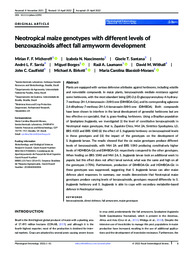Neotropical maize genotypes with different levels of benzoxazinoids affect fall armyworm development.
Neotropical maize genotypes with different levels of benzoxazinoids affect fall armyworm development.
Author(s): MICHEREFF, M. F. F.; NASCIMENTO, I. N.; SANTANA, G. T.; SARRIA, A. L. F.; BORGES, M.; LAUMANN, R. A.; WITHALL, D. M.; CAULFIELD, J. C.; BIRKETT, M. A.; MORAES, M. C. B.
Summary: Plants are equipped with various defensive attributes against herbivores, including volatile and nonvolatile compounds. In maize plants, benzoxazinoids mediate resistance against some herbivores, with the most abundant being (2R)-2-β-D-glucopyranosyloxy-4-hydroxy-7-methoxy-2H-1,4-benzoxazin3(4H)-one (DIMBOA-Glc), and its corresponding aglucone 2,4-dihydroxy-7-methoxy-2H-1,4-benzoxazin-3(4H)-one (DIMBOA). Both compounds have been shown to interfere in the larval development of generalist herbivores but are less effective on specialist, that is, grass-feeding, herbivores. Using a Brazilian population of Spodoptera frugiperda, we investigated (i) the level of constitutive benzoxazinoids in Neotropical maize genotypes, that is, Zapalote Chico, Mirt 2A, Sintético Spodoptera, L3, BRS 4103 and BRS 1040 (ii) the effect of S. frugiperda herbivory on benzoxazinoid levels in these genotypes and (iii) the impact of the genotypes on the development of S. frugiperda larvae. The results showed that the six maize genotypes produce different levels of benzoxazinoids, with Mirt 2A and BRS 1040 producing constitutively higher levels of HDMBOA-Glc and DIMBOA-Glc respectively compared to the other genotypes. When feeding on BRS 1040 and Mirt 2A, S. frugiperda larvae took an additional week to pupate, but this effect does not affect larval survival, what was the same and high on all the genotypes (>70%). Furthermore, production of DIMBOA-Glc and HDMBOA-Glc in these genotypes was suppressed, suggesting that S. frugiperda larvae can alter maize defence plant responses. In summary, our results demonstrate that Neotropical maize genotypes produce varying levels of benzoxazinoids, genotypes respond differently to S.frugiperda herbivory and S. frugiperda is able to cope with secondary metabolite-based defence in Neotropical maize.
Publication year: 2022
Types of publication: Journal article
Keywords: Benzoxazinoids, Direct defence, Fall armyworm, Maize genotypes
Observation
Some of Embrapa's publications are published as ePub files. To read them, use or download one of the following free software options to your computer or mobile device. Android: Google Play Books; IOS: iBooks; Windows and Linux: Calibre.
Access other publications
Access the Agricultural Research Database (BDPA) to consult Embrapa's full library collection and records.
Visit Embrapa Bookstore to purchase books and other publications sold by Embrapa.

